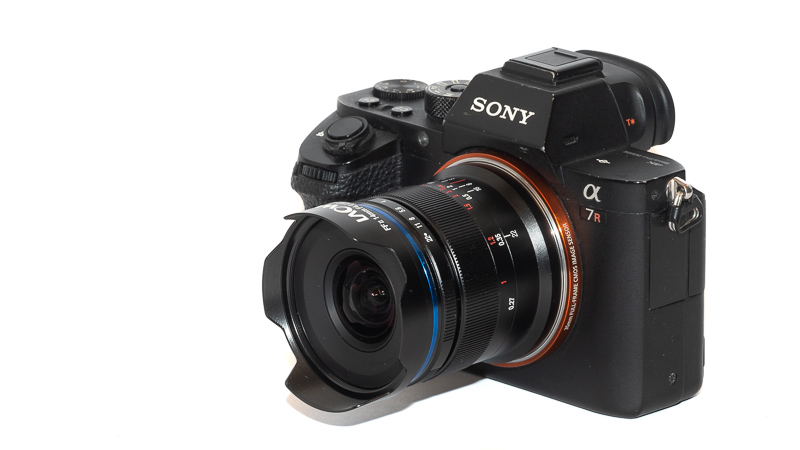
Some people who make photographs aren’t astrophotographers, and nor are they specialist hyper-wide photographers. Did I write some people? Most photographers probably fall into that category. For them, especially if they are travelling, a large fast hyper wide, or one of the excellent hyper wide zooms that are now available, is overkill: too much bulk for too little use. A tiny prime, right in the middle of the hyper wide range, makes a lot of sense. It can sit in a corner of the camera bag without taking up too much space or adding too much weight until it’s needed, and when it is needed, it will reward with easy handling. Is this Laowa the hyper-wide we have been waiting for?
Samples
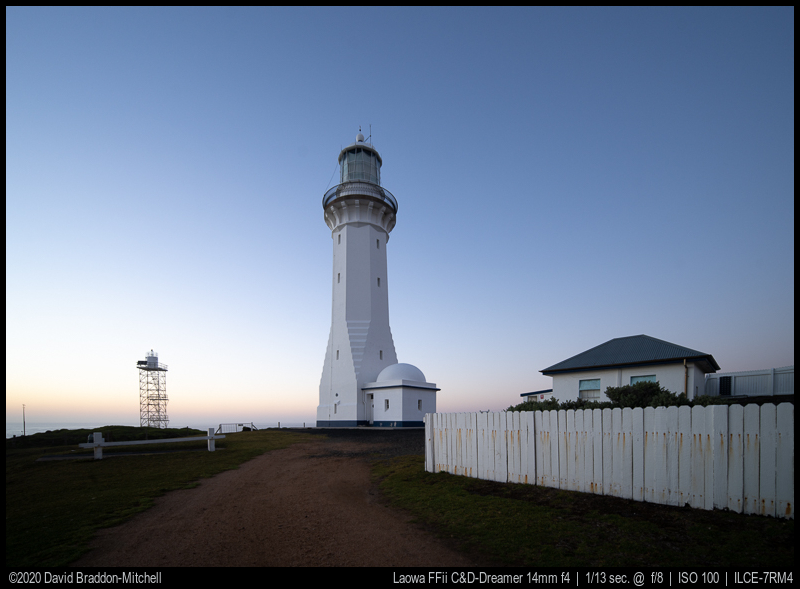
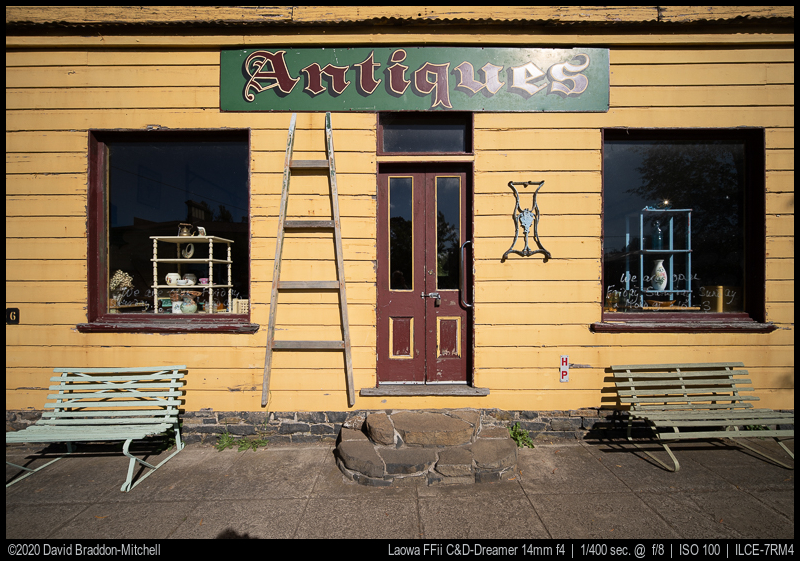
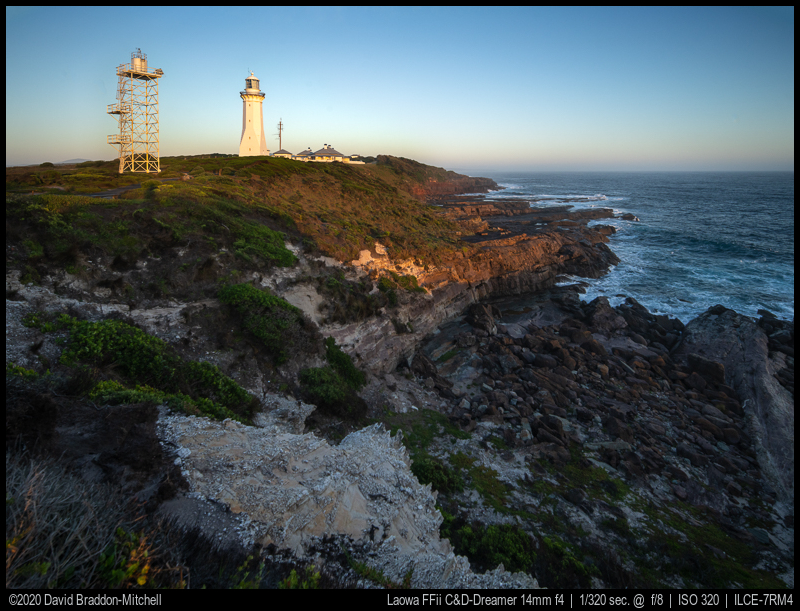

Contents
- Samples
- Specifications
- Features, Build Quality and Handling
- Infinity Resolution
- Portrait Distance Resolution
- Vignetting (Corner Shading)
- Chromatic Aberration
- Distortion and Distortion Correction
- Sunstars and Aperture Blade Effects
- Flare
- Alternatives
- Some More Samples
- David Braddon-Mitchell
- Latest posts by David Braddon-Mitchell (see all)
Specifications
This review is of the E mount version, it will also come in M, Z and Canon RF mount versions
| Diameter | max 58 mm |
| Length | 59 mm |
| Filter Thread | 52 mm |
| Weight (w/o adapter) | 228g |
| Minimum Focusing Distance | 0.27m |
| Maximum Magnification | 1:14 |
| Number of aperture blades | 5 |
| Elements/ Groups | 13/9 |
If you are interested in purchasing it, buying it from one of these affiliate links makes a small contribution to defraying the cost of this blog. You can get it at:
Direct from Laowa or B&H Photo or eBay.com
Features, Build Quality and Handling
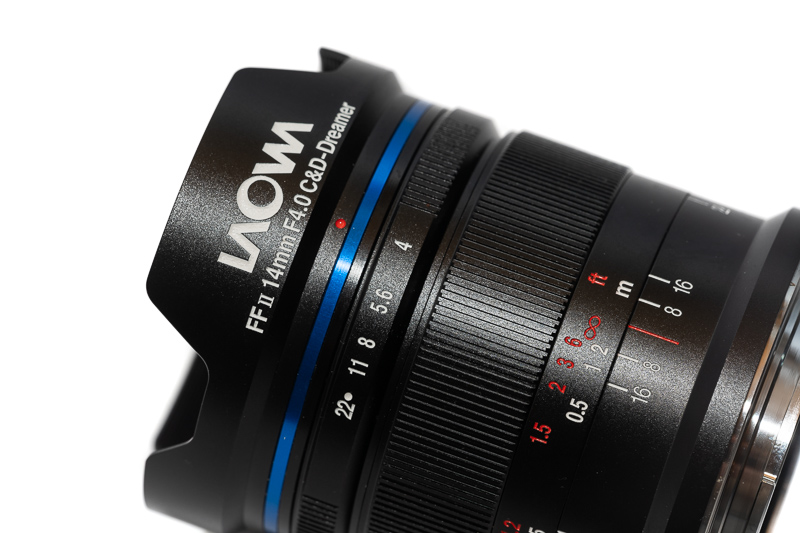
The build quality of the lens is very good indeed. It is tightly constructed from metal with what seems like a durable and attractive finish. The markings are all engraved and filled with paint. This includes the large LAOWA marking on the hood, which I find a bit tacky, but some of the team here disagree so it is plainly a matter of taste!
The focus travel is about 90° from .27 metres to infinity, and has a very nice feel
The fixed hood nevertheless allows the use of 52mm filters. I found stacking filters produced vignetting, but a single filter was fine, even an average thickness polariser. Of course polarisers are of limited use – on a lens this wide you will get very uneven effects. But it might be handy if you photographing aquaria, rock pools, wet foliage etc. I tend almost never to use any filters besides protection filters, preferring to stack exposures in post for most purposes. But it is convenient to be able to use a protection filter, or a simple ND filter if you need slow shutter speeds in bright light.
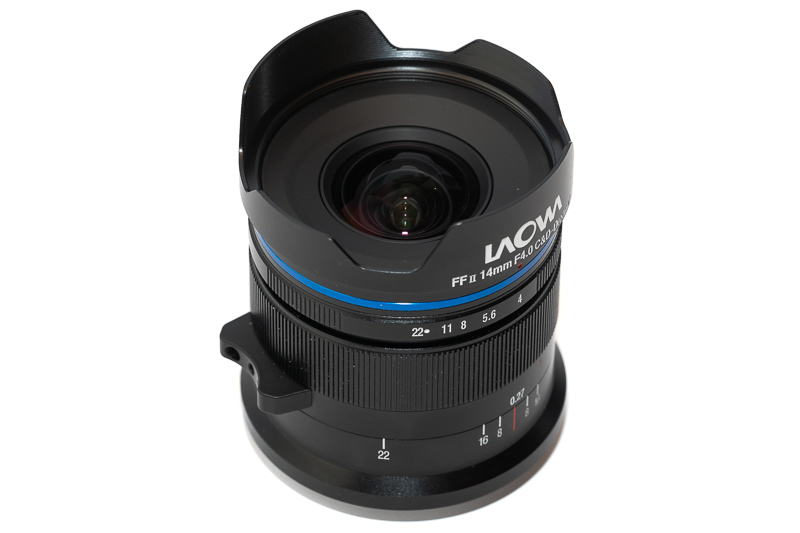
The lens has no chip in it or any electronic contacts, so there is no transmission of EXIF data. A plug in like EXIFTOOL or some other way to edit EXIF is therefore your friend when using a lens like this, if you have a large catalogue of images. This also means stabilisation will be 3 axis – though stabilisation is of mixed benefit on ultrawides, so I’m not too concerned about that.
Infinity Resolution
Here’s the usual infinity resolution image. As usual recently, I have taken to moving the camera so as to get the same subject in each location, to make comparison easier. I focussed when the subject was central, and did not change focus for midfield (intersection of rule of thirds lines) and extreme corner. Testing is on a 61MP Sony A7r4.
Centering was fairly decent, if judged by the corner images, but as we will see there are some interesting issues.
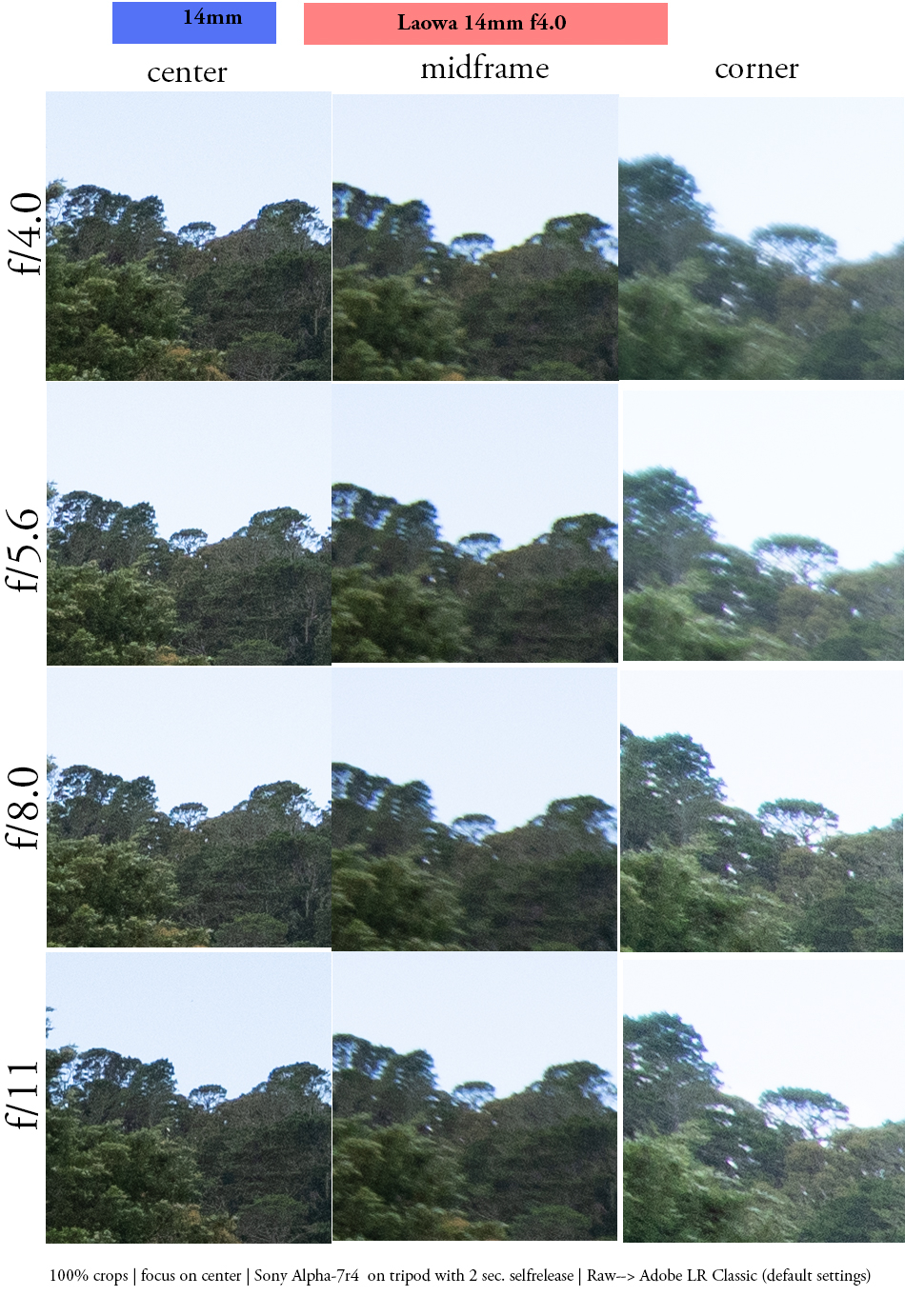
Central sharpness is excellent from wide open. Any aperture can be used to give excellently crisp images if focussing in the centre. It gets even better at f5.6; by f11 it’s still a touch better than f4. But at f16 it’s a touch worse than wide open due to diffraction, but still very usable. Corners are also pretty good for a lens this wide, very nice at f8.
But the fascinating thing is the midfield. When the image is focussed at infinity in the centre, the midfield (the rule of thirds intersection) is not very sharp at any aperture. At first I thought this was due to field curvature. This thought was reinforced by finding that the midfield improved substantially focussing it a bit more forward (towards the camera) than the centre.
So here is a comparison of the top left midfield focussed first at the centre, and then focussed on the midfield itself.
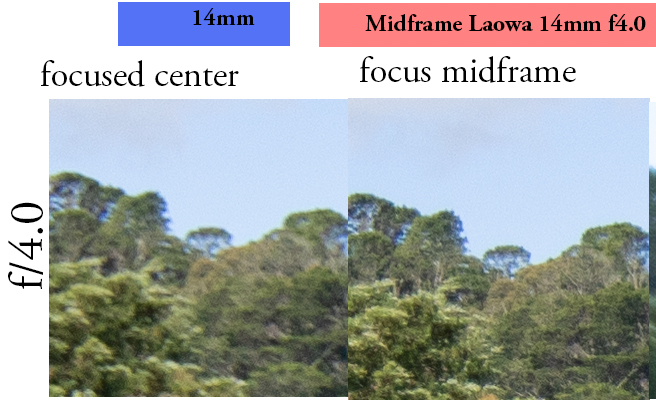
As you can see the improvement is dramatic. An obvious hypothesis is that there is infinity field curvature with a slightly complex, but not uncommon shape:

Something like this would result, when focussed on the centre, in a good centre, front focussed midfield and OK corners (forgive my hand drawing!)
I think that this is part of the story, indeed the Laowa MTF suggests a midfield drop in resolution, probably due to field curvature like this, but not, I think, as significant as I saw.
So I decided to do a field curvature test. Infinity field curvature is very time consuming to test, but at closer distances it’s possible to relatively easily test it by photographing something like a field of grass, and running the photoshop find edges filter on it, or else using the focus peaking of Fast Raw Viewer. This gives a sharpness map over distance which looks like the following:
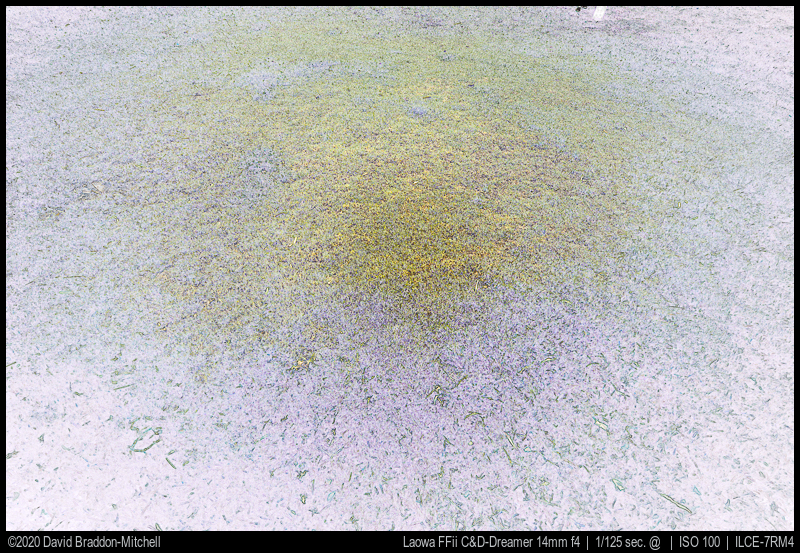
This shows us that there is a non trivial tilt to the lens something roughly like this:
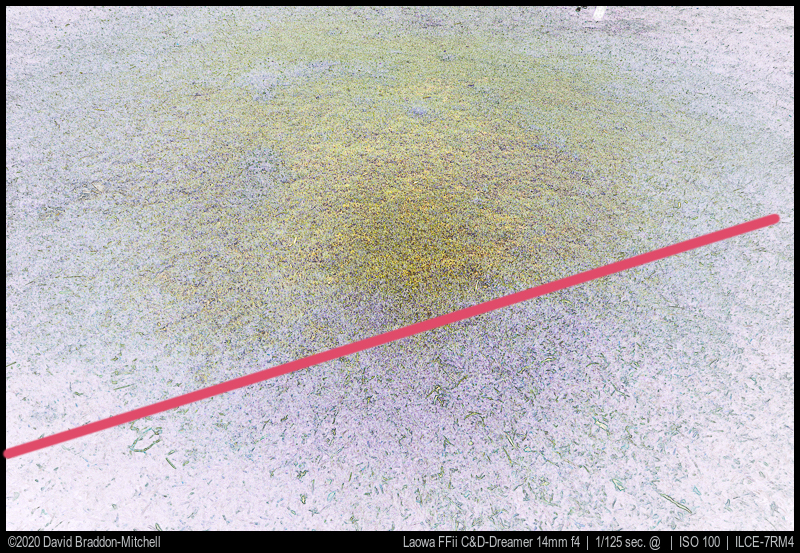
Further testing revealed that there is a midzone issue at the right hand side of the frame as well, but in that case it is improved by focussing a little behind best central infinity focus, not in front of it, confirming the tilt.
So the net result of the lens is, I think, a combination of the tilt described and a milder field curvature of the kind illustrated above.
I don’t want anyone to panic about this. The field curvature by itself could probably be dealt with by a compromise focus. The tilt makes this very hard; midzone on the left will be softer if you focus for the centre, but perhaps not unacceptable so.
How concerned should you be about the tilt? Tilt is a perennial problem with hyper wide lenses, and testing on a modern high resolution camera is very likely to reveal some tilt. The problem is that when the angle of view is so great, the smaller absolute difference in placement of the elements gives a very large angular difference in the focus field, so it becomes hard to be entirely untitled. An interesting article on Lloyd Chambers’ site (sorry paywalled, so no link) about the new and wonderful Sony 12-24 GM shows him at first enraged by the amount of tilt on such an expensive lens, but then someone pointed out that that amount of tilt is such that the smallest amount of shimming you could do with not be fine grained enough to fix it. It may be just something we have to live with given even the best consumer manufacturing techniques. That said, the amount here is moderately high, and I would hope that other samples may have less. Some other review sites, though, like Opticallimits, also received a somewhat tilted sample.
Still if you are making A2 prints or smaller (or looking at a whole image on a screen with the same dimensions) it should not be objectionable.
Portrait Distance Resolution
You might conceivably use a lens like this as a hyper wide environmental portrait lens. If you wanted all of a seated person in a frame the closest you could go would be 1.2 metres, so this is the distance I’ve chosen. What matters here is not so much even resolution across the frame, but that the eye of your subject, at whatever place you put it in the frame, is sharp when you focus on it. In past reviews I have used a live subject and focused on their eye, but this both requires a cooperative friend, and is subject to possible movement.
Instead I have focused on bank notes, which we also often use for MOD (minimum object distance) tests.
First, centre performance. Left is wide open at f4.0. right is stopped down to f5.6.
Second stopped Rule of thirds intersection. again left is wide open, right is stopped down to f5.6
Central performance at 1.2 metres is OK wide open, but gains considerably in contrast by stopping down. However the rule of thirds intersection mid field performance is a little disappointing even stopped down. This is not due to field curvature, since the lens was refocussed for the midfield at this distance.
Vignetting (Corner Shading)
The fixed hood on the lens makes my usual test which you can compare with others difficult to perform. But I measure roughly 3.2 stops of vignetting in the corners. The unfortunate thing is that it does not reduce much with stopping down, and I was still over 2.5 stops at f8. If you are shooing at ISO 100, this will pose no problem for correction: the corners will be effectively at ISO 800, and that won’t be objectionably noisy. But if you are shooting at higher ISOs and choose to correct the vignetting, there may be some visible noise in the corners.
Chromatic Aberration
There is very little visible LaCA despite the fact that it doesn’t have contacts, and so there is no auto correction happening. What traces exist are completely removed by the LaCA button in Lightroom.
And, the good news is: almost no visible LoCA. It may be an apochromatic lens, with better colour correction than many lenses advertised in this way. The next image is at f4; no point showing images stopped down any further as there is no colour fringing in front or behind the focal plane. There is, however, just a touch of blue fringing around backlit trees etc at infinity which this test doesn’t show up.
This is a very impressive result, though it should be noted the it’s not a very fast lens, which makes LoCA easier to control.
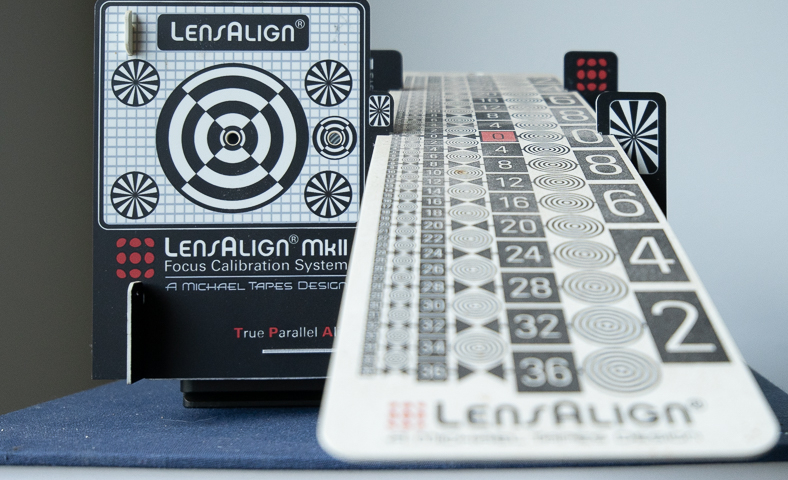
Distortion and Distortion Correction
The lens exhibits mild barrel distortion, which can be fixed completely when needed with a setting of +3 in Lightroom.
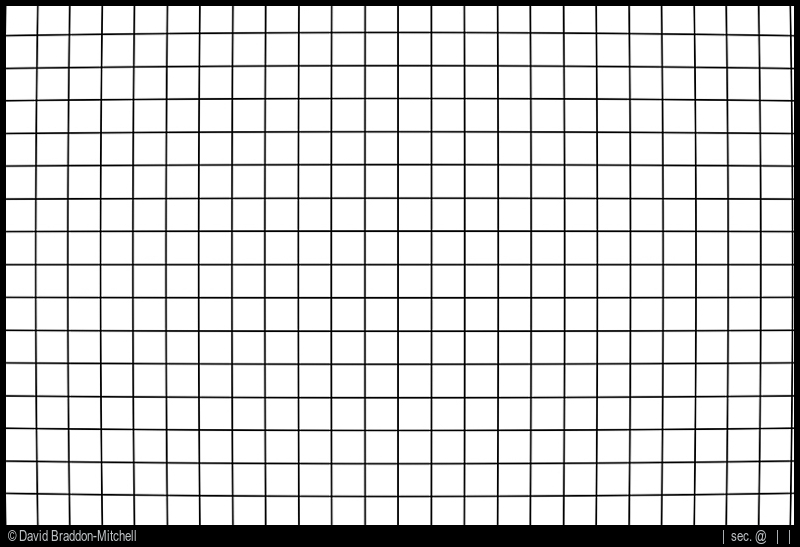
Sunstars and Aperture Blade Effects
The lens has five aperture blades. For a lens this wide that is plenty; bokeh balls rarely appear and are not large enough for pentagonal shapes to be objectionable.
It also produces very nice ten pointed sunstars, very much like the ten bladed Loxia and Voigtlaender lenses.
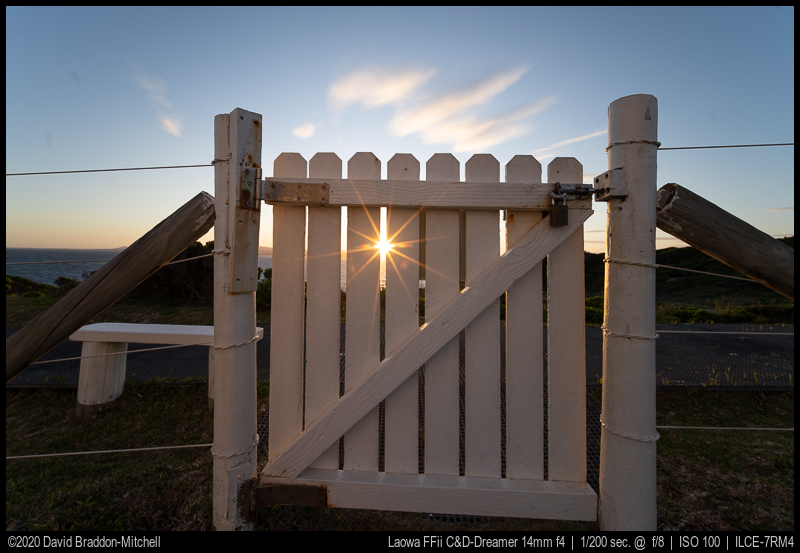
Flare
With the sun actually in the frame the lens performs very well. With the sun well outside the frame it can produce strong veiling flare, but this can be prevented my manually shading the lens with your hand. However there are two kind of ill-effects that seem to be unpreventable. When the sun is just outside the frame, I have found no way to shade it without my hand or my black cardboard shade appearing in the image.
The first such artefact is a bright semicircle: it will appear in any corner when the sun is just outside the frame.
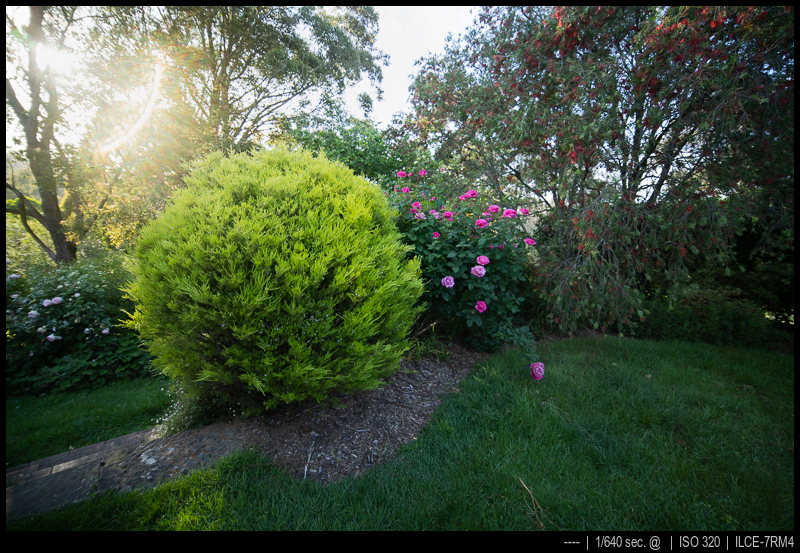
The second issue is veiling flare. If you adjust the composition just slightly so that the sun is still unshadeably close to the frame corner, the artefact is replaced by massive veiling flare, which no amount of dehazing will reduce.
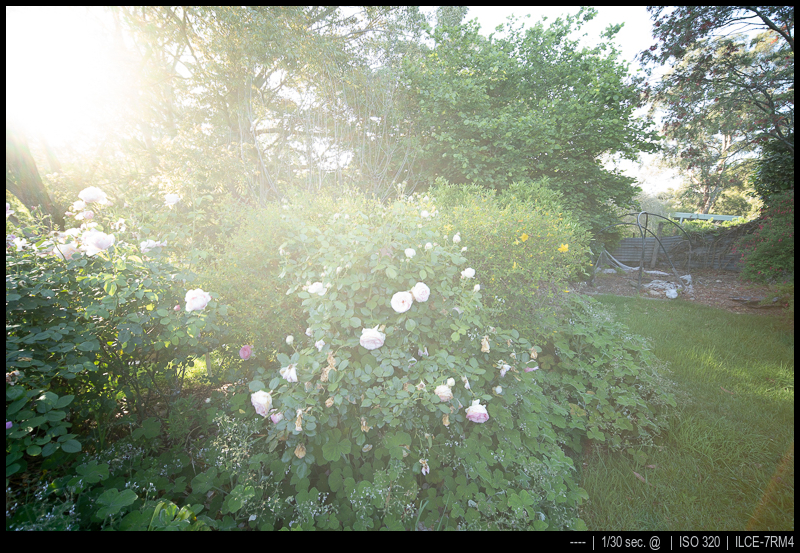
I should report though, that in actual use the lens performed well, and I never got theses sorts of effects in any scene I actually wanted to photograph. So its performance in the field was fine.
Alternatives
Samyang 14mm f2.8
Reviewed by Bastian here. This is the original copy variation horror. It’s actually a very good lens optically, if you can forgive the huge complex distortion. I had a great copy once on a different mount. But every attempt to replace it produced terrible copies. I’m not the only one to have this experience by any means! But if you can find a good copy, it’s at least as good as the Laowa. It is however much larger and heavier even if faster, has tacky cheap build quality, and just doesn’t fill the brief of the “back of the lens bag” lens.
You can buy it via affiliate link from B&H or eBay or Amazon
Voigtländer 15mm f4.5
This is the obvious competition, and unfortunately I’ve never used it. There’s a review by Bastian here. It has to be said that it has famously bad variation issues, more so than the wider CV hyperwides, so it may be no easier to find a ideal copy of it than of this lens. It probably handles backlight a little better, so may be a good choice for some.
You can buy it via affiliate link from B&H or eBay or Amazon
The Ultra-wide Zooms: Sony GM 12-24, and Sigma 14-24
We haven’t reviewed them, but there are plenty of reviews out there. Both seem to be absolutely outstanding, and perhaps as good as, or better than, any available primes. But of course they are both close to the kilogram mark, and thus aren’t really competing with the Laowa in its home territory of the ultra wide you have when you aren’t taking an ultra wide.
But if you want the best available performance at 14mm, and don’t mind the size, weight and cost, then one of these is what you need.
You can buy the Sigma via affiliate link from B&H or eBay or Amazon.
You can buy the Sony via affiliate link from B&H or eBay or Amazon.
Laowa 15mm f2
There is a review of the Laowa by Bastian here
The Laowa 15 is considerably larger than the 14; in some ways it shares features with it. It is notable less good at closer distance, for instance. It is a good value for a very fast 15, and if you need the speed then you may be prepared to accept the greater size and weight. But it’s not really competing in the slower lens of good quality to save weight and bulk niche that the 14 occupies
You can buy it via affiliate link from B&H or eBay or Amazon
Sigma 14mm f1.8
If you want get get really into astrophotography this lens may make good sense. The extra speed is worth it for astrophotography, as it gives more light per unit long exposure, but I don’t think the speed is of any real use for other kinds of photography. It’s a good, sharp lens but very large indeed and makes sense almost only for Astro.
You can buy it via affiliate link from B&H or eBay or Amazon
Legacy options
Legacy ultrawides tend to be rare, expensive and not as good as modern ones by a long way. Canon made an expensive EF 14mm f2.8 II which I had for a long time (mark 1 was terrible), it was good, but it was while the best available in any mount when it came out, it was no better optically than the Samyang (modulo distortion and build).
The closest to a legacy option that makes any sense is the Zeiss Classic 15mm f2.8, which is very good, but neither cheap nor light.
Conclusion
good
|
average
|
not good
|
So now for the final conclusion: is this the lens for someone who wants a tiny hyper wide for occasional use when travelling?
I think it might be. My principal worry with this copy is the tilt. Other than that it’s not a bad little performer for the price and size. While the possible copy variation is a worry, there is only one lens which competes in this niche, and that the Cosina Voigtländer 15mm f4.5. That lens might have slightly better flare performance, but the flare issues never really impacted me in the field with the Laowa. And the Voigtländer is also reputed to have serious copy variation issues: and there is much more evidence around that that is reliably true, since it has been available for so long.
So yes, ultimately, I think I can recommend the little Laowa. Just make sure that you can test or return your copy if the tilt is too great. Don’t expect no tilt in any hyper wide, just low enough that you can get sharpness across the frame stopped down at some kind of compromise focus position.
Again, you can buy it via our affiliate links at
Direct from Laowa or B&H Photo or eBay.com
Some More Samples
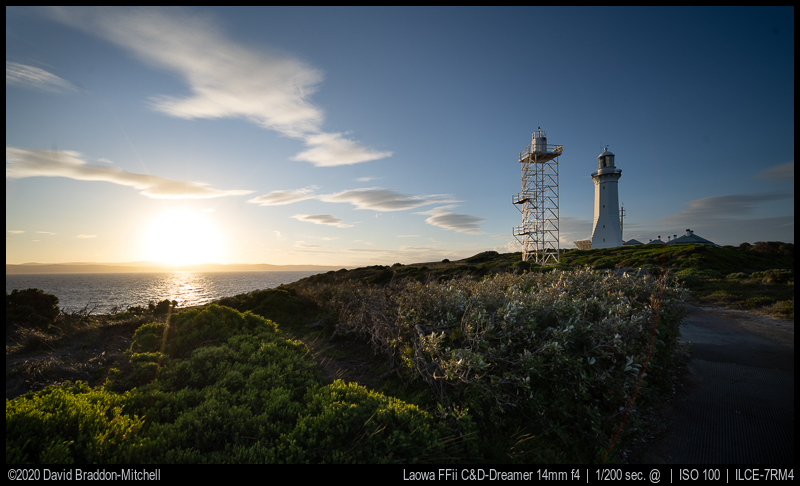
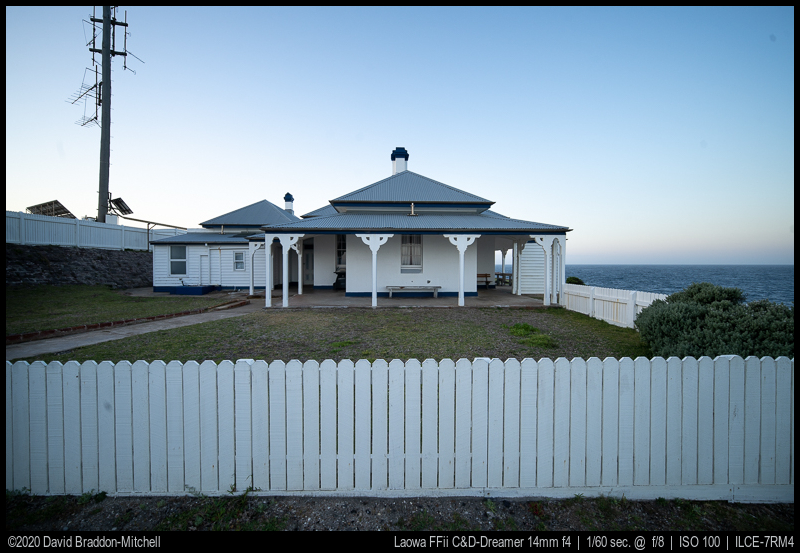
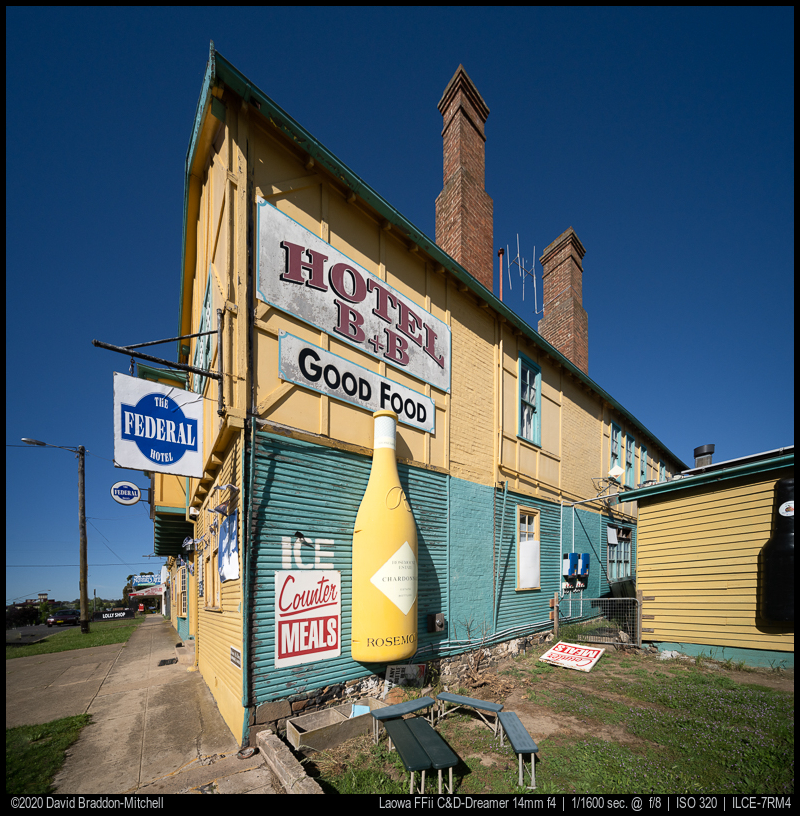
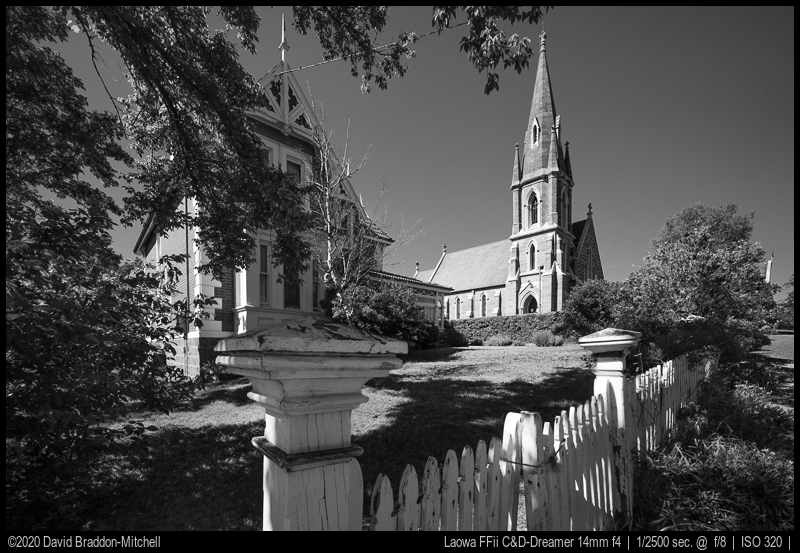
This site contains affiliate links. If you make a purchase using any of the links marked as affiliate links, I may receive a small commission at no additional cost to you. This helps support the creation of future content.
David Braddon-Mitchell
Latest posts by David Braddon-Mitchell (see all)
- Laowa FFii 90mm F2.8 CA-Dreamer Macro 2x: getting close! - August 21, 2022
- FLM Ballheads: a rediscovery - February 4, 2021
- Laowa 14mm f4 Detailed Review - December 31, 2020

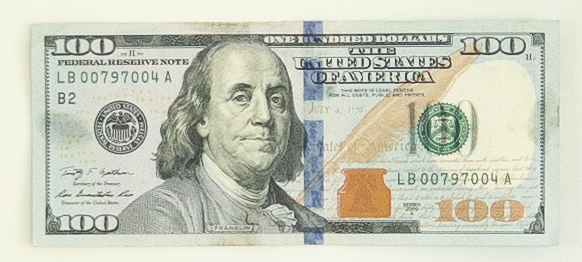
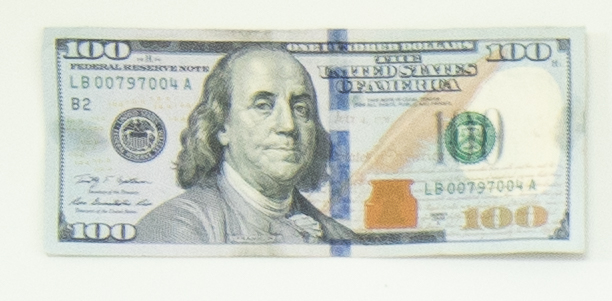
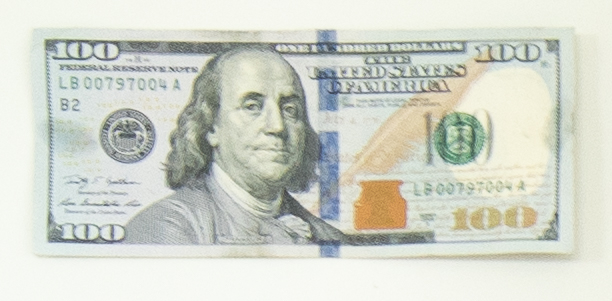
“… of the ultra wide you have when you aren’t taking an ultra wide.”
???
I think the author meant one of the more traditional ultra wides, that are larger and heavier.
As he writes at the beginning:
“..a large fast hyper wide, or one of the excellent hyper wide zooms that are now available, is overkill: too much bulk for too little use. A tiny prime, right in the middle of the hyper wide range, makes a lot of sense.”
“The X you are having when you aren’t having an X” is an expression which means that you having an X rather different from typical Xs, and which has few of the drawbacks that you might associate with Xs.
So in this case (as David(other) below says) I mean that this is ultra wide you might take when the disadvantages associated with typical ultra wides would otherwise prevent you from carrying it.
Nice review, I particularly like the coverage of the focus tilt and form of distortion. Am not too fond of the 14mm view but can see how a reasonably un-tilted instance might be attractive for people with go in their legs.
I see nothing about frog-eye coating (or weather sealing) in the official literature and for someone in a rainy region those things might be of some import.
Not sure about sealing, but a filter would do the job on the front. I personally think that weather sealing is while nice to have, less crucial that many think. I’ve been shooting often in the rain, for forty years without a single failure taking basic precautions. Salt water kills, but rain is usually fine so long as you wipe everything down and store in an low humidity environment when you get back. Of course one day you might lose some gear, but my guess is the expected cost is less than paying for sealed stuff (which might not work anyway)
Typically you are right (droplets on casing are fine if wiped off shortly). My experience rhymes, with a possible recent exception (CV) (am awaiting a diagnosis).
As for filters against rain, I admittedly only use filters occasionally and typically when I bring the pod (NDs mostly, sometimes polarizers too) but some could theoretically have a FEC-like coating I imagine? (Else wiping off a filter is a fun as wiping off a front element)
I’d be all over the Laowas if they chipped them. I had the 15/2 for a while, the lack of EXIF just killed the fun for me. I can forgive that in 30 year old legacy MF glass but I don’t want to deal with inputting focal length into my cameras every time I put on this lens.
Totally understand, but I just don’t bother mostly unless for some reason I’m going to need IBIS. IBIS doesn’t work well from any maker with ultrawides: it tends to cause blur at the edges, even if the centre is fine.
Thank you David for your review (it is a lot of time for this Details reviews)!
Thanks, Reinhard
Thank you very much, David, for this wonderful and detailed review!
Especially your description of the field curvature and the tilt is excellent. I faced similar problems with the (often praised) Laowa 15mm/2.0 Zero-D lens. I tried two copies, but both of them were decentered. In addition, even when accepting the decentering for a moment, it was very very difficult to focus them – I never got something like reasonably uniform sharpess, not even at f/8 or f/11. Finally I realized that there must have been some combination of decentering and something like a complex, slightly wavy field curvature – similar to what you have described for the Laowa 14mm/4.0 lens …
I still had hopes that this (Laowa 14mm/4.0) would be a better option for me, but your review shows that I can I can save myself the trouble to try it. (It may be very useful for other people but I am not a great photographer who can fight wavy field curvature *and* tilt in a single lens ;–). Thank you again for sparing me the headaches! So it seems I must go with one of the Zooms …
Well you might hope for not too much tilt in some copies! I’m tempted to try another.. The wavy field curvature by itself shouldn’t be a deal breaker, I think, going by the MTF from the maker, which gives an idea of how a less tilted copy should behave
I had this Venus Loawa 14mm f4 Dslr verion on my nikon d750, and only one issue bugged me was that i had to send it back and don´t look it back it was micro sharpness at the infinity.
Mirrorless had focus assistant t and other fancy tool to make manual focusing way easier, and on Dslr is just live view and zoom in on back of the display. Also zoom rin from close to far away object travels way to long making too many focus stacking images.. if focus distance would be shorter and better i think it would be excellent lens. I had 2 versions of this lens and both had same lack micro sharpness at infinity… i really had high hopes for this little one ;(
This lens’ real focal length is 14,5 mm!!!
You might be surprised, most focal lengths are rounded values.
Most (especially older) 50mm lenses are 51.6mm lenses and with zooms there is even more rounding.